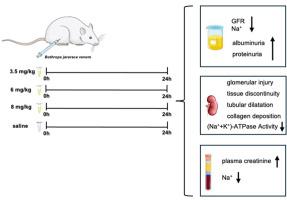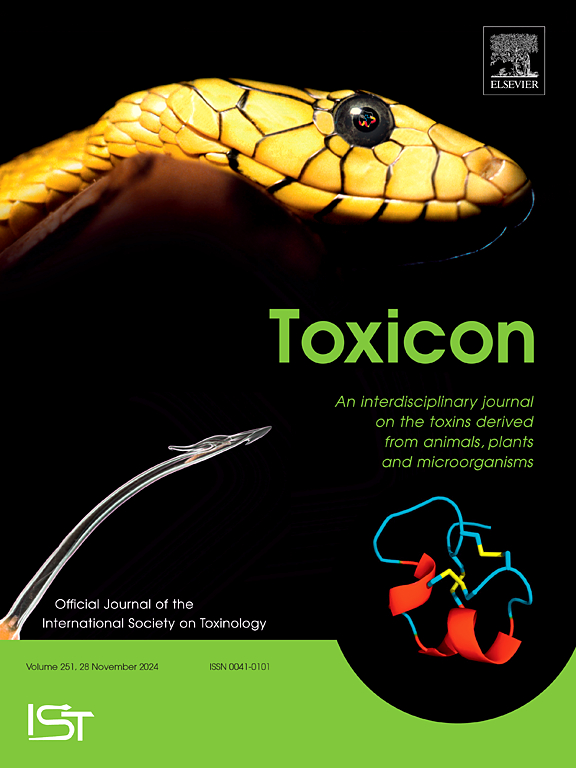Intramuscular injection of Bothrops jararaca venom provoked acute kidney injury (AKI): Underpinned by impaired renal filtration, Na+ handling, and tissue damage
IF 2.6
4区 医学
Q2 PHARMACOLOGY & PHARMACY
引用次数: 0
Abstract
Globally, about 2.5 million people are victims of snakebites annually. In Brazil, the most clinically relevant snake is the Bothrops jararaca. The symptoms of envenomation are acute inflammation at the bite site and bleeding disorders. Despite kidney failure being the main cause of death after envenomation, kidney damage is not completely understood, and there are no clinically representative in vivo models. This work aimed to characterize the acute kidney injury (AKI) induced by intramuscular injection (IM) of Bothrops jararaca (Bjc) venom in male Wistar rats. The control group received 0.9% saline solution. Three doses of venom (3.5, 6.0, and 8.0 mg/kg) were administered IM into the posterior region of the right knee. After the injection, the rats were kept in metabolic cages. The following parameters were analyzed after 24 h: the extent of muscle damage and kidney damage (urinary creatinine, proteinuria, plasma creatinine, and renal tissue histology). All rats presented a hemorrhagic lesion at the injection site in a dose-dependent manner. Biochemical parameters indicated kidney damage: plasma creatinine accumulation, decreased glomerular filtration rate, albuminuria and proteinuria, and disturbance in Na+ homeostasis. Histological analyses showed glomerular injury, tissue discontinuity more evident in the cortex and tubular dilatation, and collagen deposition. The decline in renal function and tissue damage indicated the occurrence of AKI. Therefore, a Bjc venom-induced in vivo model of renal injury has been established for future studies.

肌肉注射箭毒导致急性肾损伤(AKI):肾过滤、Na+处理和组织损伤受损。
全球每年约有 250 万人被蛇咬伤。在巴西,临床上最常见的蛇是 Bothrops jararaca。毒蛇咬伤的症状是咬伤部位急性发炎和出血性疾病。尽管肾功能衰竭是毒蛇咬伤后死亡的主要原因,但人们对肾脏损伤的了解还不全面,也没有具有临床代表性的体内模型。本研究旨在描述雄性 Wistar 大鼠肌肉注射 Bothrops jararaca(Bjc)毒液诱发急性肾损伤(AKI)的特征。对照组接受 0.9% 生理盐水。对照组接受 0.9% 的生理盐水,雄性 Wistar 大鼠的右膝盖后部肌肉注射三种剂量的毒液(3.5、6.0 和 8.0 mg/kg)。注射后,大鼠被关在代谢笼中。24 小时后分析以下参数:肌肉损伤程度和肾脏损伤(尿肌酐、蛋白尿、血浆肌酐和肾组织学)。所有大鼠的注射部位都出现了出血病变,其程度与剂量有关。生化指标显示肾脏受损:血浆肌酐累积、肾小球滤过率下降、白蛋白尿和蛋白尿以及 Na+ 平衡紊乱。组织学分析显示肾小球损伤、皮质组织间断、肾小管扩张和胶原沉积。肾功能下降和组织损伤表明发生了 AKI。因此,我们建立了一个 Bjc 毒液诱导的体内肾损伤模型,供今后研究使用。
本文章由计算机程序翻译,如有差异,请以英文原文为准。
求助全文
约1分钟内获得全文
求助全文
来源期刊

Toxicon
医学-毒理学
CiteScore
4.80
自引率
10.70%
发文量
358
审稿时长
68 days
期刊介绍:
Toxicon has an open access mirror Toxicon: X, sharing the same aims and scope, editorial team, submission system and rigorous peer review. An introductory offer Toxicon: X - full waiver of the Open Access fee.
Toxicon''s "aims and scope" are to publish:
-articles containing the results of original research on problems related to toxins derived from animals, plants and microorganisms
-papers on novel findings related to the chemical, pharmacological, toxicological, and immunological properties of natural toxins
-molecular biological studies of toxins and other genes from poisonous and venomous organisms that advance understanding of the role or function of toxins
-clinical observations on poisoning and envenoming where a new therapeutic principle has been proposed or a decidedly superior clinical result has been obtained.
-material on the use of toxins as tools in studying biological processes and material on subjects related to venom and antivenom problems.
-articles on the translational application of toxins, for example as drugs and insecticides
-epidemiological studies on envenoming or poisoning, so long as they highlight a previously unrecognised medical problem or provide insight into the prevention or medical treatment of envenoming or poisoning. Retrospective surveys of hospital records, especially those lacking species identification, will not be considered for publication. Properly designed prospective community-based surveys are strongly encouraged.
-articles describing well-known activities of venoms, such as antibacterial, anticancer, and analgesic activities of arachnid venoms, without any attempt to define the mechanism of action or purify the active component, will not be considered for publication in Toxicon.
-review articles on problems related to toxinology.
To encourage the exchange of ideas, sections of the journal may be devoted to Short Communications, Letters to the Editor and activities of the affiliated societies.
 求助内容:
求助内容: 应助结果提醒方式:
应助结果提醒方式:


